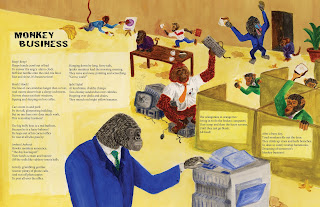2 page spread for poem “Monkey Business” I wrote
Peace Corps – 50 years

Poster for the Peace Corps’ 50th anniversary. Acrylic and mixed media on board.
Free Text Friday
“Olive oil has been more than mere food to the peoples of the Mediterranean: it has been medicinal, magical, an endless source of fascination and wonder and the fountain of great wealth and power. The olive tree, symbol of abundance, glory and peace, gave its leafy branches to crown the victorious in friendly games and bloody war, and the oil of its fruit has anointed the noblest of heads throughout history.”
Source: http://www.globalgourmet.com
Free Text Friday
Eating and Drinking
The region that is home to Florence has one of the most versatile and varied-form cooking traditions in Italy, that we have already mentioned in our tourists’ guide to Tuscany. We are going to try and provide a more specific view, limiting ourselves to the city of Florence and the area immediately around it.
Florentine cooking is linked to a tradition of simple dishes prepared with genuine, tasty but plain ingredients, which has recently been reconsidered by the world of more sophisticated cuisine. Cereals, bread, vegetable and oil (which must be extra-virgin) are the basis of many recipes that just have to be tried in one of the many restaurants in Florence.
Simple food, such as cannellini beans and other vaguely repulsive ingredients such as tripe and livers are transformed into pleasant, tasty dishes, served on both stalls and in local inns and also in luxury restaurants. We can therefore find: fagioli all’uccelletto (beans), boiled and then fried in oil and tomato sauce; trippa alla fiorentina, (tripe) covered in tomato and grated parmesan cheese; lampredotto, the darkest part of tripe, used for soups and risottos, but also liked by many locals as a filling for a sandwich; crostini toscani with liver paté. And the unforgettable “fiorentina” a cut of meat from the Chianina cow, famous worldwide, to be tried in any restaurant in Florence.
Eating and Drinking
Simple food, such as cannellini beans and other vaguely repulsive ingredients such as tripe and livers are transformed into pleasant, tasty dishes, served on both stalls and in local inns and also in luxury restaurants. We can therefore find: fagioli all’uccelletto (beans), boiled and then fried in oil and tomato sauce; trippa alla fiorentina, (tripe) covered in tomato and grated parmesan cheese; lampredotto, the darkest part of tripe, used for soups and risottos, but also liked by many locals as a filling for a sandwich; crostini toscani with liver paté. And the unforgettable “fiorentina” a cut of meat from the Chianina cow, famous worldwide, to be tried in any restaurant in Florence.











